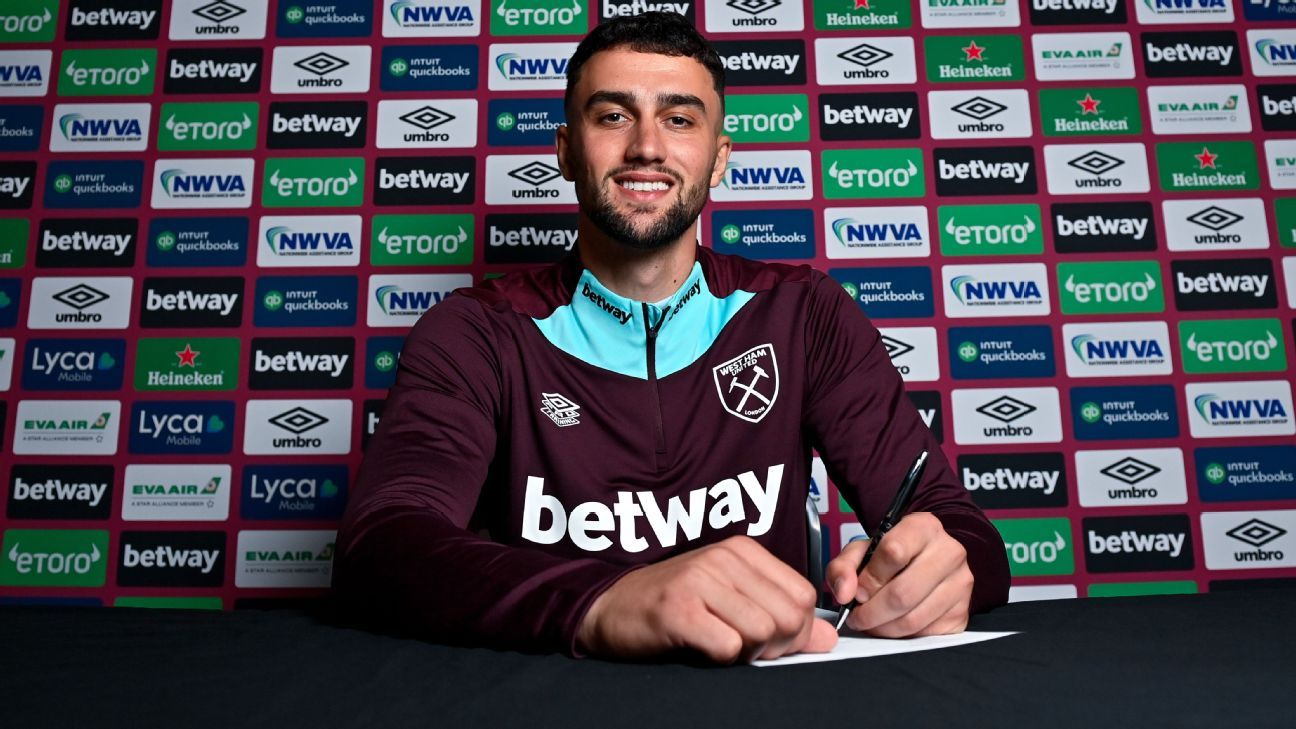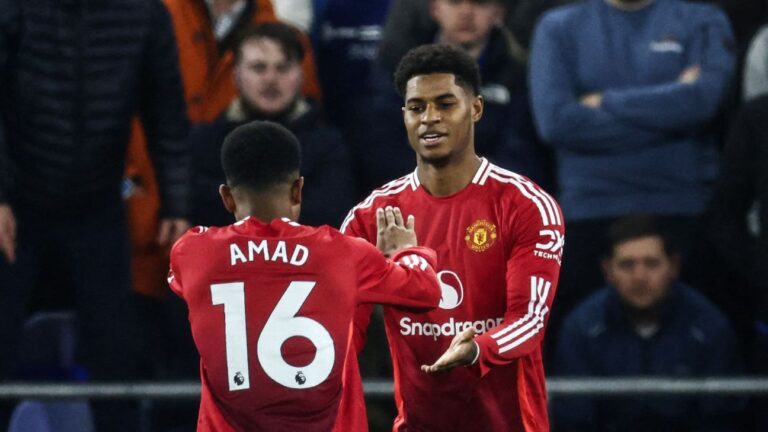Max Kilman’s move to West Ham earned Maidenhead United around £4m, which is a life-changing amount. West Ham United FC via Getty Images
Max Kilman‘s £40 million transfer from Wolverhampton Wanderers to West Ham United was one of the biggest Premier League moves in the summer transfer window. However, it wasn’t just Hammers fans celebrating the transfer; non-league side Maidenhead United will have raised a toast too given what the move meant for them.
With a little bit of forward planning, clubs further down the football pyramid can get themselves a slice of the action in major deals, and the proceeds can be life-changing. Beyond that, Kilman has also offered hope to young footballers in non-league football, the Hammers’ defender showing that biding your time and moving through the pyramid at a less-than-frenzied pace can pay off in every sense.
Kilman left Maidenhead for Wolves for a reported £40,000 in 2018, with the Magpies inserting a clause in his contract that would guarantee them a percentage of any future transfer fee. It was a gamble that might never have paid off, but it turns out Maidenhead were spot on.
Editor’s Picks
2 Related
Football clubs rarely make the details of their financial deals public, so there has been plenty of speculation over just how substantial their share of West Ham’s £40m outlay was — a 10% figure of £4m has been widely reported — but whatever the amount, it will change the way Maidenhead operate for years to come. Chairman Peter Griffin has revealed the money from the deal could even lead to the club becoming fully professional for the first time.
“From our point of view, we got to a point where we were offered an amount of money which may not have been the full amount of money we were entitled to, but the amount of money we’d have got would have been zero if he didn’t move,” he told the Maidenhead Advertiser earlier this summer.
“[That’s] the difference this money can make. This money that’s coming to us will help secure Maidenhead United’s first team, women’s team, all the community things we do and our infrastructure plans. This has given us a really huge boost for the future and if we didn’t have it, I have to say the finances in the National League are awful. They’re getting worse by the year.”
A powerful example
Chris Smalling made the transfer to Fulham from Maidstone in 2010. Neal Simpson – PA Images via Getty Images
“It sends out a really positive message,” football finance expert Rob Wilson told ESPN. “You can say to the next National League player that you can move them into a League One or Championship side and then they can graduate to the Premier League. There’s a pathway. You can say to those young players coming through ‘you can do your hard yards here, you can do your development here, and you can progress.’ This encourages all clubs — however small they are — to work on their youth development.
“Then, when that player does earn that big-money move, a future transfer clause can double a club’s revenue. For some, it can consistently mean the difference between making a profit and making a loss. In Maidenhead’s case, it’s a fantastic reward for all the work they have put in with that young player. And for football at large, it’s just a really good news story in terms of player development.”
Maidenhead might have struck gold, but they’re not the first club to have reaped the rewards of a well-thought-out transfer negotiation.
Ollie Watkins, England’s Euro 2024 semifinal hero against Netherlands, is still the toast of Exeter City. The striker earned the club an estimated £3.5m (15%) from his £30m move from Brentford to Aston Villa in September 2020, having left Exeter for the Bees in 2017.
Back in 2010, Maidstone hit it big in a similar manner when Chris Smalling — who was still playing Ryman League football for the club at age 20 — moved from Fulham to Manchester United, triggering a significant payment to a club that couldn’t afford to pay their own squad at the time.
Barnsley received over £7m when former academy product John Stones left Everton to join Manchester City for £47.5m in 2016, and Queens Park Rangers received £12.25m when winger Raheem Sterling moved to the Etihad from Liverpool for £49m the previous year. Meanwhile, the money generated from Jordon Ibe‘s £15m transfer move from Anfield to Bournemouth in 2015 helped Wycombe Wanderers pay off a £1m debt to their former owner.
But if you think all that money arrives at once, think again. Scott Twine‘s £4m move to Burnley via MK Dons in the summer of 2022 earned Swindon Town a windfall in the region of £1m. The club’s then-technical director, Sandro Di Michele, shone a light on the reality of receiving the funds in such a deal, telling the Swindon Advertiser: “If you look at the way most transfers are structured these days … clubs are shrewd, so the idea that clubs pay a lump sum up front simply doesn’t happen like that, or very rarely.”
A game of poker
Former Premier League boss, Phil Brown — who will be hoping his Kidderminster Harriers side can gain promotion back to the fifth-tier National League at the first time of asking this season — has seen most things during his managerial career. He told ESPN that clauses for future transfers can sometimes make or break any negotiation.
STREAM ESPN FC DAILY ON ESPN+
Dan Thomas is joined by Craig Burley, Shaka Hislop and others to bring you the latest highlights and debate the biggest storylines. Stream on ESPN+ (U.S. only).
“It’s like a game of cards, it’s a big game of poker,” he said. “Can it be a sticking block to a transfer? Absolutely. If you’re a third club, like Maidenhead, and you’re waiting for a transfer to go through, then the other clubs involved are fully aware that a hefty clause is going to bump the price up.
“If a club know they have to give £4m of any transfer fee away, then that naturally pushes the price up. But, at the end of the day, it’s market forces. If a club really wants a player, then they’ll pay the fee. And if a club wants to get money in, then they’ll accept an offer. But if you’re moving on a player with a substantial clause for a future transfer then you might choose to keep that under wraps in the early stages of negotiation. You obviously have to disclose it, but you want to ensure that the club are 100% interested in doing business before you lay all your cards on the table.”
Hedging your bets
Kidderminster boss Phil Brown knows firsthand how much of an impact a transfer fee can have. Nigel French/PA Images via Getty Images
The clause is a tool in any small club’s revenue-generating toolbox. But as Portsmouth‘s sporting director Rich Hughes explains, some take a move flexible approach than others.
“Some clubs have standard base clauses that they don’t look deviate from — and that can quite often cause some friction in the negotiation process,” he told ESPN. “But most successful clubs will have a flexible approach, as it provides security and can change the initial outlay. Some clubs, for example, will allow the clause to change based on a sliding scale, depending on what that outlay is. If the initial fee is £0 then a 40% clause might be inserted, if it’s £100,000 then it might be 20%, and if it’s a £200,000 fee then it might go down to 10%.”
When it’s an 18-year-old moving from the National League to third-tier League One, these percentages might result in relatively small financial wins. But, as Kilman has shown, when a player suddenly hits the big time, then a small percentage can suddenly result in an enormous payday.
“For a club like ours, and clubs in the lower leagues, then the money these sell-on clauses can generate makes a huge difference,” Brown said. “It means that clubs can continue to invest in their youth development, it might mean they can recruit new coaches or build new facilities. We’ve got 14 pitches at our training ground — I got promoted with Big Sam [Allardyce] at Bolton Wanderers with two-and-half!”
Clauses ensuring a share of future transfers fees can generate money even before a player has moved on, with those at the top of the club prepared to take a slight hit in any potential future profit by cashing in early. Brown said his former chairman at Southend United would sometimes use this approach to ensure that players’ wages could be paid on time.
“If a clause is eventually going to be worth £100,000 then, as a chairman, you might be prepared to negotiate with the club to get £50,000 or £25,000 in once that player has broken into the first team,” he said. “The clubs who would ultimately be paying out on the clause know how much that player is going to be worth because they see him play every day. Paying a clause out early might cost clubs a one-off payment, but it might eventually save them millions. When you’re working in the lower leagues, cash is king.”
play
1:25
Fjortoft: ‘Impossible to understand’ Chelsea’s motivation to sign Sancho
Jan Aage Fjortoft can’t understand why Chelsea would pursue a deal to sign Jadon Sancho from Manchester United.
An insurance policy for the big guns
While small clubs lower down the pyramid benefit most from future clauses, big clubs in the Premier League will also look to take advantage of the way that contracts are now put together, trying to future-proof their decisions.
“Manchester United have inserted a clause with defender Willy Kambwala [who signed for Villarreal in a deal that could reportedly reach £9.7m with add-ons], that might be as much as 50%,” says Wilson.
“They’re having to move players on for their own development and their own interest, but those players are still hugely valuable to the club. Manchester City have pretty much made a whole industry out of it [Jadon Sancho, Pedro Porro and Romeo Lavia are just three examples of players who have left the club and generated funds for them through subsequent moves.] It’s an insurance policy basically. Clubs are scared to lose a highly rated player and they want some kind of protection should they go on to become huge stars.
“You can end up with egg on your face, and that’s not a good look for anybody. A future clause basically means you’re hedging your bets and saying ‘look, we can’t guarantee this player enough first-team minutes, so we’re going to let them go to a club that, more often than not, is lower down the pyramid.’
“They’re letting them leave but they’re retaining this big clause. The reverse happens for the relatively small clubs that have found that gem. While 20% of £500,000 as a transfer fee isn’t a big amount of money for a club to give up, when you get to those multi-million pound transfer deals then it can add up really quickly.”
Maidenhead know better than anyone just how quickly those zeroes can add up. Kilman only made 34 appearances for the Magpies. But his one-time innocuous looking transfer to Wolves could ultimately prove to one of the most significant moments in the club’s 154-year history.
If clubs weren’t sold on the benefits of the future transfer clause before, they almost certainly are now.







